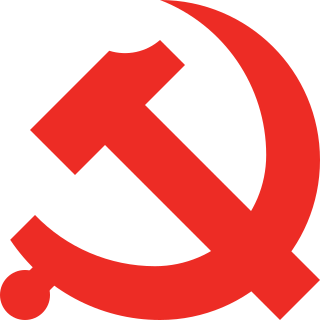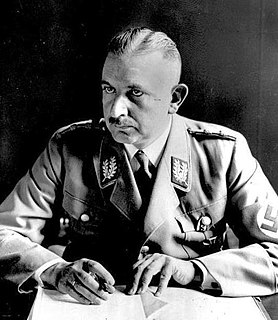Sachgebiet (Administrative Area) was a term used by the Nazi Party to describe low level administrative offices of Nazi Germany. The term first appeared in 1939 and applied to the various administrative offices set up under the authority of the Nazi Party political leadership.

The National Socialist German Workers' Party, commonly referred to in English as the Nazi Party, was a far-right political party in Germany that was active between 1920 and 1945, that created and supported the ideology of Nazism. Its precursor, the German Workers' Party, existed from 1919 to 1920.

Nazi Germany is the common English name for Germany between 1933 and 1945, when Adolf Hitler and his Nazi Party (NSDAP) controlled the country through a dictatorship. Under Hitler's rule, Germany was transformed into a totalitarian state that controlled nearly all aspects of life via the Gleichschaltung legal process. The official name of the state was Deutsches Reich until 1943 and Großdeutsches Reich from 1943 to 1945. Nazi Germany is also known as the Third Reich, meaning "Third Realm" or "Third Empire", the first two being the Holy Roman Empire (800–1806) and the German Empire (1871–1918). The Nazi regime ended after the Allies defeated Germany in May 1945, ending World War II in Europe.
The leader of a Sachgebiet was known as a Leiter eines Sachgebietes and held both a political leadership rank as well as rights to wear a special political armband.
The phrase Sachgebiet was common across all levels of the Nazi Party (Local, County, Regional, and National). In some Nazi Party regions, a smaller office known as a Hilfssachgebiet (Auxiliary Area) also would exist.

The Gestapo, abbreviation of Geheime Staatspolizei, was the official secret police of Nazi Germany and German-occupied Europe.
The politics of the People's Republic of China takes place in a framework of a socialist republic run by a single party, the Communist Party of China, headed by General Secretary. State power within the People's Republic of China (PRC) is exercised through the Communist Party, the Central People's Government and their provincial and local representation. The Communist Party of China uses Internal Reference to manage and monitor internal disagreements among the citizens of People's Republic of China. Document Number Nine was circulated among the Chinese Communist Party in 2013 by Xi–Li Administration to tighten control of the ideological sphere in China to ensure the supreme leadership of the Communist Party will not be challenged by Western influences. The PRC controls mainland China, Hainan island, Hong Kong, Macau and some South China Sea islands.

The Central Politburo of the Communist Party of China, formally known as the Political Bureau of the CPC Central Committee and known as Central Bureau (中央局) before 1927, is a group of 25 people who oversee the Communist Party of China. Unlike politburos of other Communist parties, power within the politburo is centralized in the Politburo Standing Committee, a smaller group of Politburo members.
A prefecture is an administrative jurisdiction or subdivision in any of various countries and within some international church structures, and in antiquity a Roman district governed by an appointed prefect.
In many countries, a mayor is the highest-ranking official in a municipal government such as that of a city or a town.
Führer is a German word meaning "leader" or "guide". As a political title it is associated with the Nazi dictator Adolf Hitler.
Nazi Germany cultivated the Führerprinzip, and Hitler was generally known as just der Führer.
In modern Chinese politics, the paramount leader of the Communist Party of China and the government of China is an informal term for the most prominent political leader in the People's Republic of China. The paramount leader is not a formal position nor an office unto itself and the term gained prominence during the era of Deng Xiaoping (1978–1989), who was able to wield power without necessarily holding any official or formally significant party or government positions at any given time.

A Gauleiter was the party leader of a regional branch of the Nazi Party or the head of a Gau or of a Reichsgau. The word can be singular or plural, depending on the context. Gauleiter was the second highest Nazi Party paramilitary rank, subordinate only to the higher rank Reichsleiter and to the position of Führer. During World War II, the rank of Gauleiter was obtained only by direct appointment from Adolf Hitler.
In the military, a political commissar or political officer, is a supervisory officer responsible for the political education (ideology) and organization of the unit they are assigned to, and intended to ensure civilian control of the military.
This is a list of words, terms, concepts and slogans of Nazi Germany used in the historiography covering the Nazi regime.
Some words were coined by Adolf Hitler and other Nazi Party members. Other words and concepts were borrowed and appropriated, and other terms were already in use during the Weimar Republic. Finally, some are taken from Germany's cultural tradition.
Blockleiter from 1933 was the title of a lower Nazi Party political rank responsible for the political supervision of a neighborhood. Referred to in common parlance as Blockwart, the officials were in charge to form the link between the Nazi authorities and the general population. The derogatory term Blockwart ("snoop") survives in German colloquial language.

Markos Vafiadis was a leading figure of the Communist Party of Greece (KKE) during the Greek Civil War. His family came originally from the island of Chios.

Ranks and insignia of the Nazi Party were paramilitary titles used by the National Socialist German Workers Party (NSDAP) between approximately 1928 and the fall of Nazi Germany in 1945. Such ranks were held within the political leadership corps of the Nazi Party, charged with the overseeing the regular Nazi Party members.
Zellenleiter was a Nazi Party political title which existed between the years of 1930 and 1945. A Zellenleiter was higher in rank than a Blockleiter and was in charge of a "Nazi Cell", composed of eight to twelve city blocks.
Units and commands of the Schutzstaffel were organizational titles used by the SS to describe the many groups, forces, and formations that existed within the SS from its inception in 1923 to the eventual fall of Nazi Germany in 1945.
The NSDAP Office of Colonial Policy was a Nazi Party office formed in 1934. Its stated objective was to formulate plans for the re-taking of the former German colonies. The office lost much of its meaning after the start of World War II, and was dissolved after the reversal of Nazi Germany's military victories in 1943.
Ortsgruppenleiter was a Nazi Party political rank and title which existed between 1930 and 1945. The term first came into being during the German elections of 1930, and was held by the head Nazi of a town or city, or in larger cities, of a neighbourhood, for the purposes of election district organization. After 1933, through the process of Gleichschaltung, the position of Ortsgruppenleiter evolved into the Nazi leader of a large town or city or of a city district.
Dienstleiter, was a high-ranking Nazi Party political rank of Nazi Germany which existed between 1933 and 1945. The rank was first created after the Nazi assumption of power and served as the second highest rank of the Reichsleitung Nazi Party organizational level, subordinate to the Reichsleiter.

Stellenleiter was a Nazi Party political rank which existed between 1933 and 1938. The rank was created as a mid-level political position intended to replace the older rank of Zellenwart, also known as Zellenleiter. In the early Nazi Party rank organization, the position of Stellenleiter was senior to Mitarbeiter and junior to Amtsleiter.







